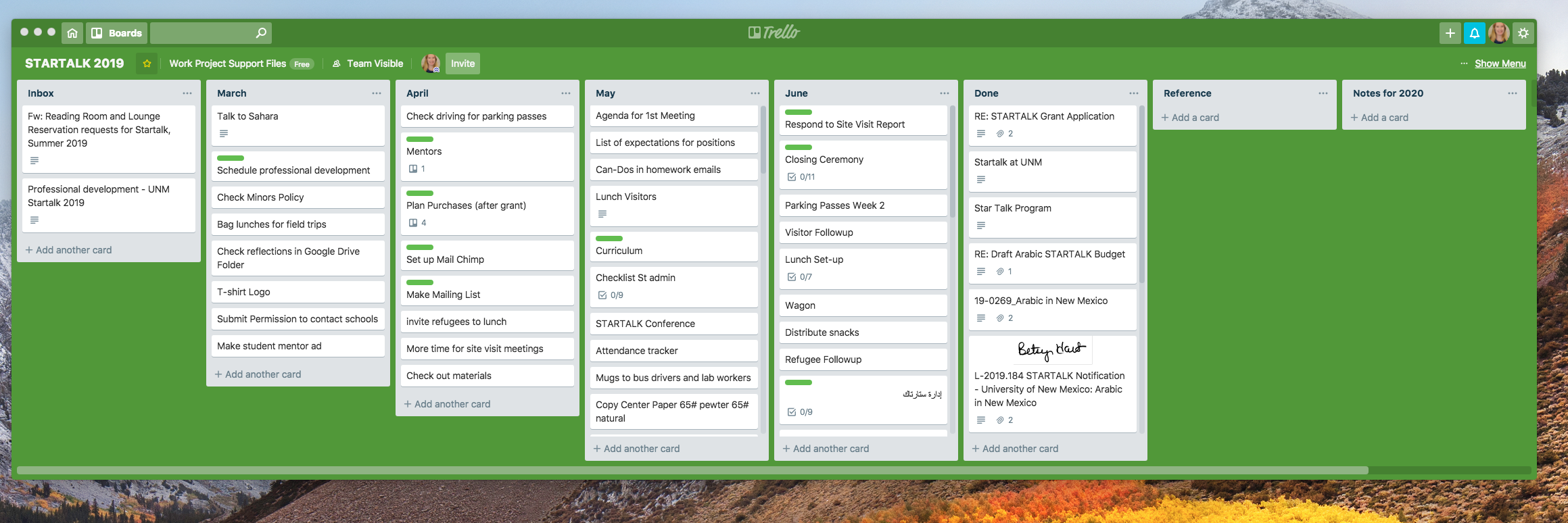Note: You can now find the template for this board on my Trello Boards page!
Last Fall, I wrote about how I use Trello to organize my teaching. Another area I find Trello very useful for is organizing large events or programs, in my case dance competitions and our summer Arabic STARTALK program. Although a dance competition and a summer program for middle and high school students seem like very different events (and they are!) the structure for organizing them is similar. So, while I’ll focus on planning the STARTALK program in this post, I think a similar structure can be used for any event.
New Board, Old Todos
The first thing I do is make a separate Trello board for the event. The first list in the board is the “Inbox”, which is where I save items pertaining to that event (usually from my email). Then, I copy the “done” and “notes for next year” lists from the previous year, and these become a large todo list. Then, I add lists for the months leading up to the event, and distribute the todos across them. Once that month is passed, I move any remaining tasks to the next month and archive the list (so you don’t see January and February anymore). Since these types of events are on top of my regular job and life, I usually have very limited time to work on them in a given week, so it’s important to evenly spread out the prep tasks for months in advance so I’m not caught by surprise in a time crunch. Some of them are also time-sensitive, for example marketing needs to start in January, and admissions needs to be completed by April. When I get closer to the event, I split the monthly list into weekly or daily lists, as the event starts to take up more of my time. For STARTALK, I usually switch to weekly lists in May and June.

Reference and Notes for the Next Year
Following these lists, I have a “done” list, a reference list, and then a “Notes for 2020 list”. The done list is where completed tasks go (yay!). The reference list is for information that isn’t actionable, but that I need, such as a quote, or reservation information. I store these cards in the reference list, but also attach them to whatever actionable card they are relevant to using the Trello attach function. As you can see, there is nothing in this list yet, but there will be as we get closer! For example, if I get an email with the bus reservation information for a field trip, I would save it to this list but also attach it to the card for that field trip.

The notes for 2020 list is perhaps the most useful, as most of these events repeat on a yearly basis. As things happen that I want to record for next year, I put them in this list. Then, the following year, I copy this list to the new Trello board and distribute the cards on it among the todos. Most of these items are minor details that make the programs run more smoothly, but that I would not remember a year later (such as the fact that the building is locked from the outside at 5:00, so our orientation should start at 4:30, not 5:00). By continually recording them, and then copying this list to the following year, I’m able to stay on top of these details without exerting mental effort to remember them.
Checklists for Everything
Another useful feature is checklists, for example for daily admin tasks during the program, a list of contacts to send marketing material to, or tasks for a specific program activity, like the closing ceremony checklist pictured here. Again, because I copy these cards from the previous year and add any notes I made, I don’t have to worry about forgetting steps from year to year.

Linking to the Semester Board
I also link this board to a card called “STARTALK” in my semester board, which is where I keep track of all my projects for a given semester. Then, when I’ve blocked time to work on STARTALK, I just click through to the special STARTALK board, and start working on whatever tasks are listed that month.
Hopefully, this can give you some ideas of how Trello can organize large projects and events for you, especially if they repeat on a yearly basis. Do you use Trello or a similar system in another program? Let me know if you have comments or useful tips to improve my system!
